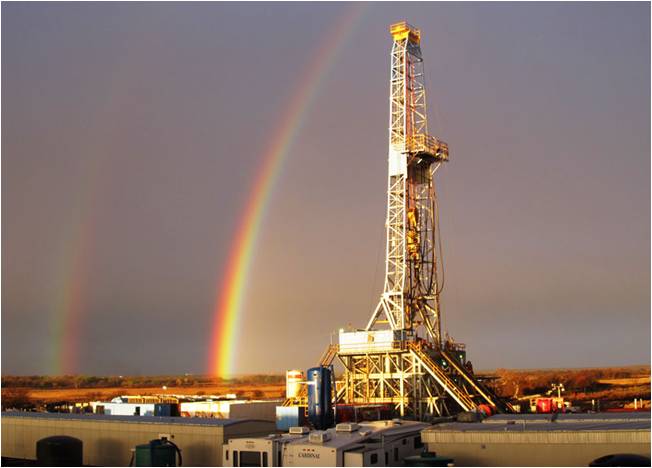
Distress in the Oil & Gas Industry (Part 1)
With oil prices having fallen more than 50% from June 2014 to January 2015, most pundits expect more companies in the oil & gas (O&G) industry will face significant financial distress in 2015, forcing many to either consolidate or file for bankruptcy. Already this year several large oil and gas companies, like WBH Energy L.P., BPZ Resources, Dune Energy, Inc., Quicksilver Resources, Inc., American Eagle Energy Corp., ERG Resources, LLC and Duer Wagner III Oil & Gas, have filed for chapter 11 bankruptcy because they could no longer service their debt obligations and/or fund their ongoing operations.
pundits expect more companies in the oil & gas (O&G) industry will face significant financial distress in 2015, forcing many to either consolidate or file for bankruptcy. Already this year several large oil and gas companies, like WBH Energy L.P., BPZ Resources, Dune Energy, Inc., Quicksilver Resources, Inc., American Eagle Energy Corp., ERG Resources, LLC and Duer Wagner III Oil & Gas, have filed for chapter 11 bankruptcy because they could no longer service their debt obligations and/or fund their ongoing operations.
While oil prices did rebound slightly in the Spring and Summer of 2015, the anticipation is that there will still be many oil and gas companies with the same financial distress during the second half of 2015, as oil prices remain much lower than $100 per barrel. Based on the author’s experience as debtor’s counsel and lender’s counsel in several oil and gas restructurings and workouts over the past two decades, this Article (in two parts) will discuss the oil and gas industry in the United States, the players in this industry, the financial distress experienced in this industry and the unique challenges that O&G companies face in a bankruptcy setting.
Because each of these relevant topics merits a lengthy discussion, the Article will be broken down into two parts, with the first part focusing on the trends in the industry, the players in the industry and the financial problems that some of these players are experiencing. The second part will delve into the various aspects of bankruptcy laws that are generally implicated when an O&G company files for bankruptcy protection.
Trends in U.S. Oil & Gas Production
The United States is the world’s top producer of oil and natural gas, having overtaken Russia and Saudi Arabia several years ago. The rise to the top was fueled by new drilling techniques, such as horizontal drilling and hydraulic fracturing, which have unlocked vast quantities of oil and gas from shale rock formations – especially in North Dakota and Texas.
According to the Drilling Productivity Report, dated April 2015, by the U.S. Energy Information Administration (EIA), 95% of U.S. production comes from 7 regions. These regions, spread out throughout the U.S., are known as the Bakken Shale, Eagle Ford Shale, Permian Shale, Haynesville Shale, Niobrara Shale, Marcellus Shale and Utica Shale. The diagram below demonstrates where these regions are located.
The EIA’s more recent Drilling Report shows that, while production is expected to be down slightly from month to month, overall production in each region has increased from last year.
The Players in the Industry
Companies in the oil and gas industry are generally referred to as upstream, midstream and downstream companies. Upstream companies, also known as exploration and production (E&P) companies, find new areas where there is untapped oil and gas and drill wells for new production. The E&P companies commonly obtain the right to develop an area, drill wells and extract minerals from the subsurface through oil and gas leases entered into with the landowners or mineral interest owners. Such oil & gas leases provide E&P companies with a “working interest” in the minerals underneath the ground. This working interest grants an E&P company the exclusive right to develop and receive a net profit from the minerals produced. Because oil and gas exploration and development is extremely capital-intensive, you commonly see E&P companies farmout a portion of their working interests to other parties to assist in the development of the land and mitigate the risks of drilling unsuccessful wells.
Midstream companies are the ones that ship and store oil and gas. They ultimately move the oil and gas from the production fields to the refining facilities and ultimately to the buyers. These companies commonly include pipeline companies that transport oil and gas over long distances across the U.S. After the initial pipeline transfer, midstream companies may require further transportation by land, with the use of rail and trucking companies. Barges are also required to transport oil over oceans and large bodies of water. Finally, midstream companies include storage facilities, where surplus oil and gas is stored before reaching refining facilities.
Downstream companies are the buyers who purchase and refine oil and gas into consumable products. These companies purchase and receive crude production from mid-stream companies and refine such production into gasoline and other petro-based products.
In addition to upstream, midstream and downstream companies, oil field services companies (OFS) play a significant role in the O&G industry. In general, OFS companies provide products and services to the E&P companies, but they typically are not producers of oil and natural gas themselves. For example, OFS companies often provide the rigs and other equipment used to drill wells. They also provide the massive workforce for the exploration, drilling and build out of new production facilities. As of 2013, more 10,000 companies operated in the OFS industry, ranging from Fortune 500 companies to small local retailers.
Similarly, there are companies that provide ancillary services to the people in the oil & gas industry. These ancillary services include things like providing man camps, apartments, restaurants, entertainment and other related services. These companies do not represent a significant portion of the revenue in the O&G industry, but are still tied to the success and distress in this industry.
Financial Stress in the Energy Industry
Usually, a dog wags her tail, and not visa versa. Similarly, according to John Maynard Keynes, demand in products usually dictates the amount of related manufacturing and production and not visa versa. However, sometimes in the economy there is a disconnect between supply and demand, and the consumer–not the producer–benefits from the gap. That is what we are currently experiencing with the recent excess production, where an oversupply has resulted in cheaper pricing. While consumers in the U.S. are enjoying this environment, many companies in the industry are not benefiting as a result and, in fact, are experiencing substantial financial distress.
Upstream Companies
Let’s start with the finders and the drillers, i.e., the exploration companies. The reason for the distress of E&P companies is that exploration and production is a capital-intensive industry, notwithstanding the recent technological advances. Given the costs involved, there is a “break-even” point where the price of crude oil must be in order for E&P companies to maintain operations. This break-even point depends, in large part, on the difficulty in drilling in certain shale formations. When the break-even point is reached—whether it be $50 or $60 dollar per barrel—cash-strapped E&P companies are compelled to either borrow more money or obtain more investment capital to continue operations. Unfortunately, banks and investors are currently more conservative in their lending and investment practices.
In addition, many E&P companies are facing potential defaults on their loans with lenders (bondholders and banks), due to the reappraised value of their oil and gas reserves, which have been pledged as collateral to the lenders. Lenders generally require these reserves to be appraised every six months, and the next round of appraisals, starting in the Third Quarter of 2015, will likely reveal that the values of the pledged reserves are substantially less than required by the respective loan agreements. At that point, the lenders will be entitled to foreclose on their collateral, forcing these E&P companies, absent obtaining waivers of the loan defaults, to sell their assets to generate revenue or file for bankruptcy.
OFS Companies
Because OFS companies provide the equipment and workforce necessary for the operations of the E&P companies, OFS companies are similarly impacted when E&P companies reduce their drilling operations.
The oil rig count in the U.S. is one of the benchmarks in determining the need for oil field services. According to Baker Hughes (which has been monitoring rig counts since 1944), the average U.S. rig count has been declining regularly on a monthly basis and is 52% lower than last year. While large companies, like Halliburton and Baker Hughes, can survive the significant downturn in demand, smaller companies are expected to experience significant financial distress, leading many of them to sell their assets, merge or file bankruptcy.
In addition to the reduction in revenues, OFS companies face similar challenges trying to comply with their loan covenants with lenders. Similar to the E&P companies, loans to OFS companies generally require a collateral base; however, with OFS companies, the collateral base is comprised of equipment such as oil rigs. When this equipment is idle, like in cases where rigs are stacked, the value of the collateral base diminishes significantly, leaving these companies with insufficient collateral to borrow future funds and, in some cases, causing them to breach loan covenants with their lenders. The sale of assets also will likely provide OFS companies with little relief, given the depressed value of equipment in this environment.
Ancillary Services
Similarly, companies that provide ancillary services to the people in the oil & gas industry are likely to face financial distress. Considering that the OFS workforce is currently experiencing significant layoffs, ancillary services are likewise experiencing a decline in the demand. Those companies that have borrowed too much money in recent years may not be able to generate sufficient income to maintain profitable operations or even meet their debt obligations. Because lenders are even more skittish about lending to these specialized businesses, when these companies run out of cash, they will likely have little options but to file bankruptcy.
Wrap Up
While the price of oil has rebounded within recent months, because world production remains high, prices may not reach their historic levels, again, for several years. In the meantime, there will continue to be a fair amount of distress in the oil & gas industry, as demonstrated, due to the domino effect oil prices have on smaller companies.
Indeed, there currently exists a fair amount of companies that are on a general downward cash-burn trajectory. However, if these companies burn up too much of their liquidity, hoping that their luck will turn, they will soon discover that they have diminished options to restructure.
While some companies have found respite with alternative lenders who are willing to make riskier loans, such loans are generally unavailable to the vast majority of smaller players. Such loans are also generally on costlier terms, given the higher risks involved for the lenders. And if the companies cannot turn operations around by the time such loans mature, they may be facing bigger problems down the line.
Pundits predict that many companies ultimately will have no other option but to file bankruptcy. Case in point, the Commercial Finance Association–Southwest Chapter is hosting its Fourth Annual Energy Summit on September 16, 2015, where several leading experts in the field will discuss the outlook in the industry.
As mentioned, Part II of this Article will discuss the unique challenges that oil & gas companies face in a chapter 11 bankruptcy. In short, Chapter 11 does provide relief, if it is adequately planned ahead of time. Stay tuned for more!






